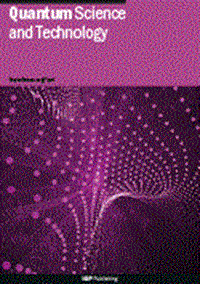可扩展的高维多部纠缠与捕获离子
IF 5
2区 物理与天体物理
Q1 PHYSICS, MULTIDISCIPLINARY
引用次数: 0
摘要
我们提出了一种制备具有d = 3或4个内能级的N原子的广义greenberger - horn - zeilinger (GHZ)态的方案。我们将N个量子位的著名的单轴扭转(OAT)哈密顿量推广到量子位,通过在每对量子位水平之间包含相等强度的OAT相互作用,我们称之为平衡OAT (BOAT)协议。类似于量子比特的OAT,我们发现从任意数量的原子N的产物态开始,BOAT下的动力学导致ququits (d = 3)和ququits (d = 4)的GHZ态的形成。虽然BOAT可能在多个平台上实现,但在这里,我们提出了使用捕获离子系统的具体实现方法。我们证明,制备这些态的保真度高于阈值,可以排除比广义GHZ态更低维的纠缠。对于qutrits,我们还提出了一种协议来约束保真度,该协议只需要离子晶体的全局寻址和其中一个电平的单次读出。我们的研究结果为当前基于原子的量子硬件上高维多部纠缠的可扩展生成和认证开辟了一条道路。本文章由计算机程序翻译,如有差异,请以英文原文为准。
Scalable high-dimensional multipartite entanglement with trapped ions
We propose a protocol for the preparation of generalized Greenberger–Horne–Zeilinger (GHZ) states of N atoms each with d = 3 or 4 internal levels. We generalize the celebrated one-axis twisting (OAT) Hamiltonian for N qubits to qudits by including OAT interactions of equal strengths between every pair of qudit levels, a protocol we call as balanced OAT (BOAT). Analogous to OAT for qubits, we find that starting from a product state of an arbitrary number of atoms N, dynamics under BOAT leads to the formation of GHZ states for qutrits (d = 3) and ququarts (d = 4). While BOAT could potentially be realized on several platforms where all-to-all coupling is possible, here we propose specific implementations using trapped ion systems. We show that preparing these states with fidelity above a threshold value rules out lower dimensional entanglement than that of the generalized GHZ states. For qutrits, we also propose a protocol to bound the fidelity that requires only global addressing of the ion crystal and single-shot readout of one of the levels. Our results open a path for the scalable generation and certification of high-dimensional multipartite entanglement on current atom-based quantum hardware.
求助全文
通过发布文献求助,成功后即可免费获取论文全文。
去求助
来源期刊

Quantum Science and Technology
Materials Science-Materials Science (miscellaneous)
CiteScore
11.20
自引率
3.00%
发文量
133
期刊介绍:
Driven by advances in technology and experimental capability, the last decade has seen the emergence of quantum technology: a new praxis for controlling the quantum world. It is now possible to engineer complex, multi-component systems that merge the once distinct fields of quantum optics and condensed matter physics.
Quantum Science and Technology is a new multidisciplinary, electronic-only journal, devoted to publishing research of the highest quality and impact covering theoretical and experimental advances in the fundamental science and application of all quantum-enabled technologies.
 求助内容:
求助内容: 应助结果提醒方式:
应助结果提醒方式:


